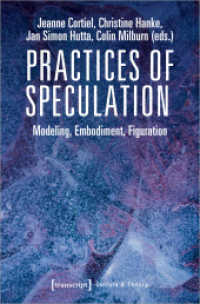Full Description
Dramatic shifts in the demographic and labor diversity of American faculty have pressed institutions and the profession to clarify who the "real" faculty are, from tenured to adjunct faculty. Efforts to equalize respect, resources, and treatment, although laudable, may be missing a vital aspect of the conversation: the role of collegiality and the collegium. Collegiality, the cultural, structural, and behavioral components, and the collegium, or the shared identity collegiality serves, are ancient concepts that raise timely questions for the faculty profession:What is it about the history of the professoriate in America that has rendered the collegium inadequate and yet so important in an age of differentiated labor? How might a renewed vision for collegiality bring clarity to the question of which faculty should be regarded as experts? How can we adapt and leverage these important concepts for a professoriate that is increasingly diverse by demographics and employment category in ways that result in a more inclusiveand robust profession? Engaging in these questions through the extant literature will call readers into a compelling new conversation about the needs of and possibilities for the professoriate.This is the fourth issue of the 43rd volume of the Jossey-Bass series ASHE Higher Education Report. Each monograph is the definitive analysis of a tough higher education issue, based on thorough research of pertinent literature and institutional experiences. Topics are identified by a national survey. Noted practitioners and scholars are then commissioned to write the reports, with experts providing critical reviews of each manuscript before publication.
Contents
Executive Summary 07Foreword 11Defining and Contextualizing Collegiality and the Collegium 15Introduction and Context 15Focus of the Monograph 17Part I: Contemporary Definitions of Collegiality and the Collegium 19Collegiality 19The Collegium 21Part II: The Contextual Imperative for Revisiting Collegiality 22Faculty Employment Differentiation 26Summative Implications for Collegiality and the Collegium 33The Fragmented Origins of the Collegium 35Part I: Historic Origins of the Collegium 36The Medieval Era: The Earliest Forms of the Collegium 36Forms of the Collegium in Europe 38Colonial Colleges: The Dominance of the Board 40From Tutor to Professor: Shifting Roles in the Nineteenth Century 42The Turn of the Twentieth Century: Setting the Stage for the Collegium 45The Interwar Period: Faculty Demands for Authority 51The Postwar Period: Factors Supporting the Collegium 53The Fragmented Collegium in America 54Part II: Relocating Collegiality in the Modern Era 56Collegiality as an Institutional Archetype 57Summary 60Collegiality and the Collegium in the Contemporary University 61Part I: Maxims of Collegiality and the Collegium in the Contemporary University 62Maxim One: The Collegium Describes a Collective But Exclusive Membership 62Maxim Two: Collegiality Exists Across Overlapping Domains of Structure, Culture, and Behavior, But Is Not Complete in Any One of Them 65Maxim Three: Collegiality Contains an Expectation of an Inclusive Governance Process that Persists in Importance Despite the Presence of Other Governance Forms 67Maxim Four: The Focal Point of Collegiality Is the Pursuit of Shared Purpose, Despite the Divergent Claims and Interests of Various Academic Units 68Maxim Five: Collegiality Implies a Willingness to Be Scrutinized by One's Expert Peers 69Maxim Six: Collegiality Is Fraught with Tensions, Contradictions, and Unresolved Questions 71Maxim Seven: Despite Challenges, Collegiality Still Has Value 73Part II: NTTF Collegial Expectations and Experiences 75NTTF Collegial Expectations 75NTTF Collegial Experiences and the Factors that Shape Them 78Individual Factors Affecting NTTF Collegiality Experiences 79Interpersonal Factors Affecting NTTF Collegial Experiences 82Institutional Factors Affecting NTTF Collegiality Experiences 83Summary 87Imagining the Organic Collegium for a New Era 88The Collegium Revisited 90Accessing the Collegium: The Role of Expertise 92Collegiality and the Collegium in an Era of Faculty Differentiation 5Why Conditional Collegiality Matters 95Exclusion of Voices 95Exclusion of and Effect on Diverse Voices 96Weakened Faculty Body 97Envisioning an Organic Collegium 98Moving Forward: Addressing the Questions 107Future Research Directions 109What Is the Relationship Between Faculty "Type" and Expectations and Experiences Regarding Collegiality? 109What Conditions or Factors Shape Collegial Interactions and Climates? 109Does Access to the Collegium and Collegiality Vary Across Institutional Types? 110What Are the Effects of Collegiality? 110How Are Institutions Building Collegial Environments for NTTF? 111Conclusion: Today's Faculty and the Organic Collegium 111References 114Name Index 123Subject Index 127About the Author 129








